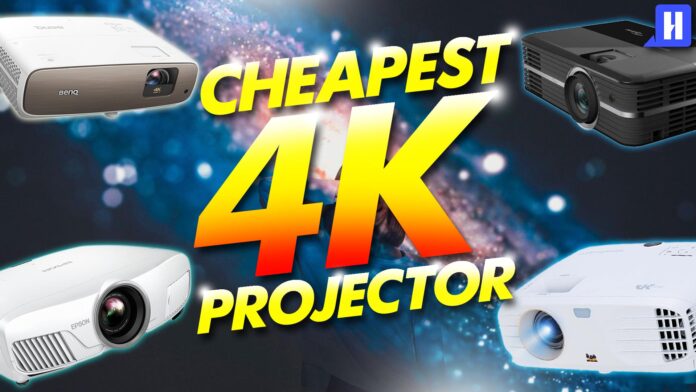
Projectors offer many benefits over televisions, with screen size being the most obvious. Most consumer-grade projectors can produce a picture upwards of a hundred inches. If you want a similarly sized television, you would have to spend a fortune.
The images projectors produce are also easier on the eyes compared to televisions. That is because reflecting light off white backgrounds causes less fatigue than looking directly at light emitted from a display. Moreover, projectors are easier to maneuver in as home decor as it doesn’t require you to mount a massive box on your wall.
On the other hand, projectors have particular requirements. You need to have a room with minimal ambient light and a projection screen to get the best picture quality.
In the past, 4K projectors had a high barrier to entry because of their steep prices. As a result, the only viable options for home theater builders were the more affordable lower-resolution alternatives. However, the cost of 4K projectors has dropped significantly because of innovations in display technology, making them more accessible to consumers.
In this article, we will cover some of the most affordable options on the market to find the cheapest 4K projector you can get your hands on today. We also put together a comprehensive buyer’s guide at the end of the list to ensure you’re making the right purchase.
Contents of this Page
| Rank | Preview | Product | Display Type | Brightness | Price |
|---|---|---|---|---|---|
| 1 |  | Epson Home Cinema 4010 | 3LCD | 2,400 ANSI Lumens | |
| 2 | LG CineBeam HU70LA | DLP | 1,500 ANSI Lumens | ||
| 3 |  | Optoma UHD51A | DLP | 2,400 ANSI Lumens | |
| 4 |  | ViewSonic PX727-4K | DLP | 2,200 ANSI Lumens | |
| 5 |  | BenQ HT3550 | DLP | 2,000 ANSI Lumens | |
| 6 |  | BenQ TK850 | DLP | 3,000 ANSI Lumens | |
| 7 |  | Optoma UHD35 | DLP | 3,600 ANSI Lumens | |
| 8 |  | BenQ TK800M | DLP | 3,000 ANSI Lumens | |
| 9 | 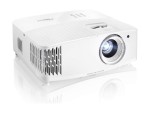 | Optoma UHD30 | DLP | 3,400 ANSI Lumens | |
| 10 |  | Vivitek KH2288 | DLP | 2,000 ANSI Lumens |
Best 4K Projectors Under $2,000
Epson Home Cinema 4010
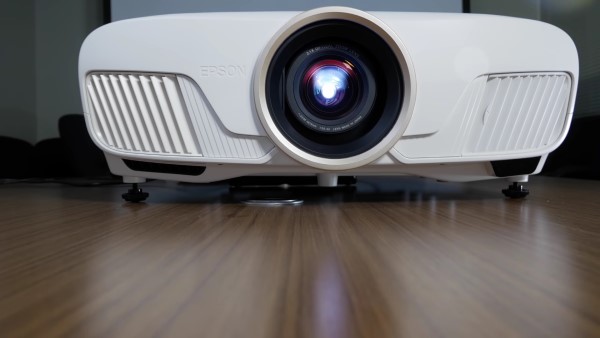
|
Specifications |
|
| Display Type | 3LCD |
| Maximum Screen Size | 300 inches |
| Brightness | 2,400 ANSI Lumens |
| Dynamic Contrast Ratio | 200,000:1 |
| Throw Ratio Range | 1.35:1 – 2.84:1 |
| Lamp Life | 5,000 hours |
| Noise Level | 31 dB |
| Input Lag | 28 ms |
| Warranty | 2 Years |
|
Ratings |
|
| Performance | 10 |
| Design | 8 |
| Ease of Use | 10 |
| Value | 10 |
The Epson Home Cinema 4010 relies on advanced pixel-shifting technology to deliver stunning 4K resolution. It introduces a group of advancements, including a new algorithm to produce on-screen results on par with full 4K alternatives.
The Home Cinema 4010 uses a lens that features a unique aspheric glass structure to prevent surface dust from appearing on the final projected image. This structure also lets the lens produce outstanding overall brightness and focus uniformity.
The Home Cinema 4010 shows no observable smearing or annoying rainbow artifacts common among 4K LCD projectors. This projector also offers key improvements from its predecessor, including a better lumen rating for white and color brightness and a higher contrast ratio. These improvements are enough to create noticeable enhancements in black level and shadow detail in dark images.
Epson implemented a refined tone-mapping algorithm into the Home Cinema 4010 for better rendering of HDR10 content. Meanwhile, it carried over some key benefits from its predecessor, namely the stellar lens, a dynamic iris to boost contrast and deepen blacks, and support for 1080p 3D Blu-ray. It also includes the same Digital Cinema mode that produces 100% of the expanded DCI-P3 color space. Some of the other notable features that define this projector are the motorized focus function for zooming, lens shift, and support for up to ten lens memory positions.
In terms of pricing, the Home Cinema 4010 costs similar to full 4K budget projectors that use 4K DLP imaging chips. However, it offers a wide range of user-friendly features not often found in competitors at the same price range. It is incredibly durable, has a motorized lens, a lens memory, a dynamic iris, and a wide zoom ratio.
LG CineBeam HU70LA
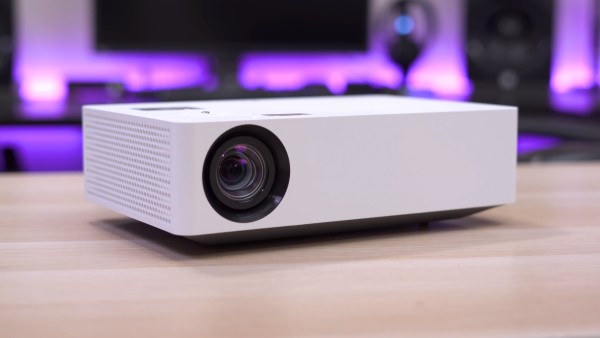
|
Specifications |
|
| Display Type | DLP |
| Maximum Screen Size | 140 inches |
| Brightness | 1,500 ANSI Lumens |
| Dynamic Contrast Ratio | 150,000:1 |
| Throw Ratio Range | 1.22:1 – 1.53:1 |
| Lamp Life | 30,000 hours |
| Noise Level | 30 dB |
| Input Lag | 43 ms |
| Warranty | 1 Year |
|
Ratings |
|
| Performance | 8 |
| Design | 8 |
| Ease of Use | 7 |
| Value | 8 |
The LG CineBeam HU70LA is best described as a 4K UHD television that uses a projector for its display. It is more suitable for the average consumer than hardcore videophiles or home theater enthusiasts. Its high lumen rating makes this projector ideal for use in ambient light, but you can find alternatives with better dark-room image quality at the same price range.
The CineBeam HU70LA behaves like a smart television, but it is compact enough to be portable. It features all the bells and whistles you would expect from a smart television, including a tuner, a user-friendly interface, and support for voice commands. While you can use this projector as the centerpiece of a home theater, it is more appropriate as a replacement for a big-screen television.
One of the standout features of the CineBeam HU70LA is the comprehensive web-streaming platform that comes at no additional cost. It is also a remarkably compact and versatile device, making it ideal for any occasion. You can easily set it up in any room or take it outdoors for backyard movie nights. You can even use it for presentations during business meetings or conferences and impress your colleagues with its sharp resolution.
The CineBeam HU70LA gives you access to platforms like Netflix and Amazon Prime Video directly from the remote. This projector also supports Google Assistant, allowing you to open your favorite services and shows through voice commands. The included remote has control buttons, an air mouse, and a microphone to input your voice commands.
The CineBeam HU70LA has no trouble getting bright enough to light a large screen in rooms with or without ambient light. You can even use it in daylight or with a window near the screen and still get decent image quality.
Overall, the CineBeam HU70LA makes a compelling case to attract everyday consumers. The long lamp life makes it suitable for daily use, and the excellent default color accuracy means users don’t have to tweak settings to get the best image quality out of the box. It is geared towards users who are interested in using a projector as a big-screen television. While its black level and contrast aren’t optimal for dark-room viewing, those downsides become insignificant with ambient light. It is an excellent projector with a unique combination of attributes and a comprehensive streaming media platform.
Optoma UHD51A
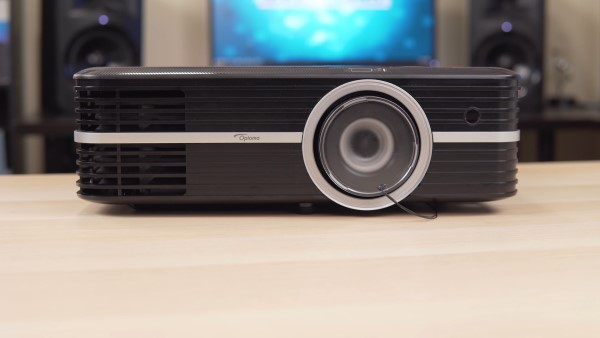
|
Specifications |
|
| Display Type | DLP |
| Maximum Screen Size | 302 inches |
| Brightness | 2,400 ANSI Lumens |
| Dynamic Contrast Ratio | 500,000:1 |
| Throw Ratio Range | 1.21:1 – 1.59:1 |
| Lamp Life | 15,000 hours |
| Noise Level | 28 dB |
| Input Lag | 68 ms |
| Warranty | 1 Year |
|
Ratings |
|
| Performance | 9 |
| Design | 9 |
| Ease of Use | 9 |
| Value | 10 |
The Optoma UHD51A is among the very first 4K projectors to support voice control through Amazon Alexa. It uses the latest 4K DLP chipset and features an RGBRGB color wheel and support for 3D 1080p content. The integration of Alexa lets you turn the device on and off, adjust the volume, change the input source, and control the media player using voice command.
The UHD51A features frame interpolation to reduce motion blur and produce fluid images. It also supports wireless display from mobile devices using the optional dongle.
The UHD51A has a 2,400 lumen rating, but some tests measured the peak brightness at 1,690 lumens in the brightest color mode. Nevertheless, it is bright enough to illuminate a large screen in rooms with or without ambient light, even in energy-saving mode.
One of the most significant downsides of the UHD51A is the low brightness uniformity. It is pretty disappointing, especially compared to its alternatives at the same price range. Nevertheless, this projector’s replacement lamps are also relatively affordable compared to the other options on this list.
When the UHD51A was initially released, the support for voice control was one of its strongest selling points. However, more alternatives like the LG CineBeam HU70LA now offer more comprehensive voice command features. Optoma promises to add more voice control options in future updates, such as switching between display modes and color modes and tweaking frame interpolation settings.
Overall, the integration of frame interpolation, support for mobile devices, and the built-in media player makes the UHD51A a compelling option for anyone putting together a home theater system. It has a relatively high input lag that makes it unsuitable for gaming, but it is an excellent device for any other use case.
ViewSonic PX727-4K
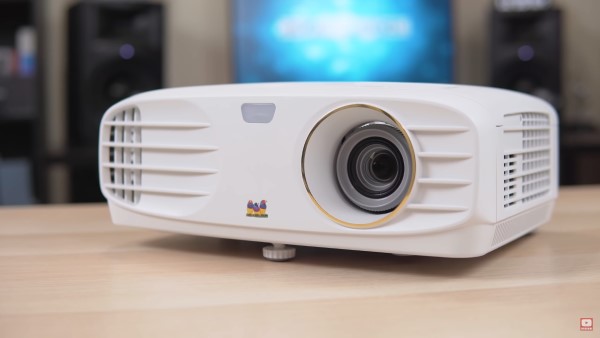
|
Specifications |
|
| Display Type | DLP |
| Maximum Screen Size | 300 inches |
| Brightness | 2,200 ANSI Lumens |
| Contrast Ratio | 12,000:1 |
| Throw Ratio Range | 1.47:1 – 1.76:1 |
| Lamp Life | 15,000 hours |
| Noise Level | 33 dB |
| Input Lag | 53 ms |
| Warranty | 3 Years |
|
Ratings |
|
| Performance | 10 |
| Design | 8 |
| Ease of Use | 9 |
| Value | 10 |
The ViewSonic PX727-4K is at the forefront of making high-resolution projection affordable for the average consumer. It is one of the most affordable projectors that use the latest 4K DLP chipset, making it an excellent addition to your home theater system.
ViewSonic has extensively worked on color optimization for its line of home theater projectors, and it has achieved stellar results over the past few years. The PX727-4K produces balanced and accurate colors right out of the box, thanks to the proprietary RGBRGB color wheel. It also delivers sharp and detailed images that are on par with premium alternatives.
The PX727-4K stands out among competitors at the same price range in terms of image sharpness, color balance, contrast, saturation, image stability, and motion fluidity. Its performance can appeal to videophiles and home theater enthusiasts who work with a limited budget. It may not have the stunning black levels of the Vivitek HK2288, but it does well in many other essential viewing aspects.
All in all, the PX727-4K is a straightforward and affordable projector that offers a ton of compelling premium features. It provides incredible value for its price and is a worthy addition to any entertainment system. If you’re looking for a gaming projector, you may want to look elsewhere since this device has a considerably high input lag.
Best 4K Projectors Under $1,500
BenQ HT3550
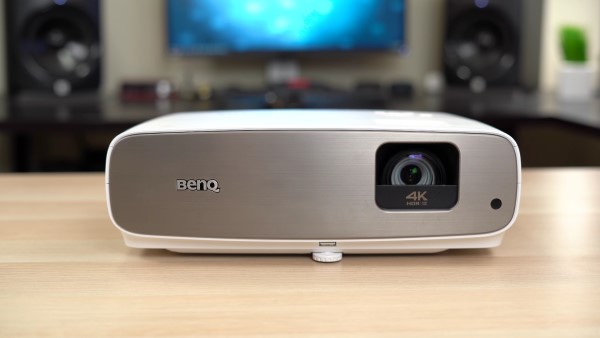
|
Specifications |
|
| Display Type | DLP |
| Maximum Screen Size | 200 inches |
| Brightness | 2,000 ANSI Lumens |
| Dynamic Contrast Ratio | 30,000:1 |
| Throw Ratio Range | 1.13:1 – 1.47:1 |
| Lamp Life | 15,000 hours |
| Noise Level | 30 dB |
| Input Lag | 50 ms |
| Warranty | 3 Years |
|
Ratings |
|
| Performance | 8 |
| Design | 9 |
| Ease of Use | 10 |
| Value | 10 |
The BenQ HT3550 offers plenty of valuable features at its price point. This projector is one of the brand’s top-tier budget home theater projectors that delivers outstanding performance with very few compromises.
The HT3550 has a smaller zoom range, smaller vertical lens shift, and no horizontal lens shift compared to its mid-tier alternative, the HT5550. BenQ understandably made these adjustments to keep the cost down while making it more appealing to budget consumers. However, it does include the same video processing and color management capabilities to produce remarkable image quality. It may lack some of the features of its more expensive alternative, but it gives you the same bang per buck.
The HT3550 uses the latest 4K DLP chipset to achieve the highest possible resolution with the help of four-phase pixel shifting. It has a six-segmented RGBRGB color wheel, a wide color gamut setting, and an impressive dynamic contrast ratio of 30,000:1 for an excellent viewing experience.
The HT3350 was one of the first projectors to integrate the new generation of 4K DLP chipsets. This chip effectively minimizes the dark frame around the image that has been an inconvenience in previous models. Although this dark band is imperceptible on screens with wide black light-absorbing bezels, it is noticeable in the area surrounding the image on a screen with narrow bezels. This new chip reduces the dark frame to under an inch wide to make it less of an annoyance.
The HT3350 works best on a low table placed just under the screen or mounted on the ceiling above it. It features a mask in front of the lens that effectively blocks stray light from spilling onto a ceiling or tabletop without blocking the image. The small vertical lens shift allows you to quickly correct minor vertical displacements to match the image without tilting the projector or making keystone adjustments.
The HT3550 has serviceable built-in stereo speakers that can get pretty loud. You can take this device out for backyard movie night without having to bring an entire speaker system. Nevertheless, the rear panel houses analog and optical audio output jacks if you want high-quality audio.
The HT3350 also supports HDR10 and HLG. The HDR10 modes work well right out of the box, but the projector also allows you to tweak the image to your preference. This projector also delivers in terms of brightness. You can use it in rooms with or without some ambient lighting.
When it comes to contrast and shadow detail at lower resolutions, the HT3350 can compete with premium alternatives that cost twice as much. The excellent tone mapping in this projector gives it an edge over the competition at the same price range.
The HT3550 features a modest vertical lens shift that makes installation more straightforward. It also has design elements such as the aforementioned lens mask that prevents stray light from spilling onto the ceiling or tabletop.
Overall, it’s hard not to recommend the HT3350 for anyone looking for an affordable high-resolution projector. It offers exceptional value for a very attractive price. Unfortunately, like most of the other options on this list, this projector has a considerably high input lag, making it the wrong choice for gaming.
BenQ TK850
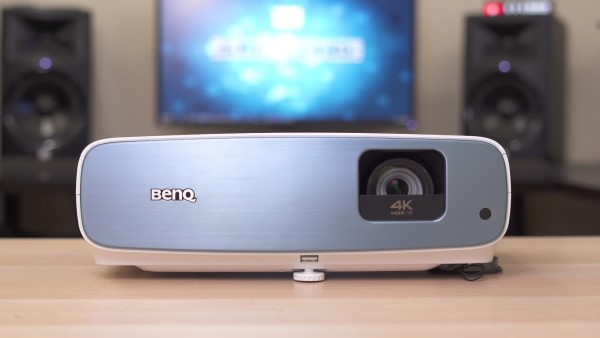
|
Specifications |
|
| Display Type | DLP |
| Maximum Screen Size | 300 inches |
| Brightness | 3,000 ANSI Lumens |
| Dynamic Contrast Ratio | 30,000:1 |
| Throw Ratio Range | 1.13:1 – 1.47:1 |
| Lamp Life | 15,000 hours |
| Noise Level | 30 dB |
| Input Lag | 83 ms |
| Warranty | 3 Years |
|
Ratings |
|
| Performance | 8 |
| Design | 9 |
| Ease of Use | 10 |
| Value | 10 |
The BenQ TK850 is virtually identical to the HT3350 in terms of specifications and design. It uses different accent colors for the front and rear panels to distinguish it from the HT3550. More importantly, it uses a different color wheel that gives it a significant brightness boost over the HT3550. However, the higher brightness rating makes it slightly worse in terms of color gamut, color accuracy, and black levels.
The TK850 is explicitly designed for moderately-lit family rooms because of its high lumen rating. It is a suitable replacement for a big-screen television situated in a room with some ambient light. If you’re looking for a projector specifically for a darkened home theater, the HT3350 is undoubtedly the superior option. Both these projectors have considerably high input lag, so they’re not the best options for gaming.
Optoma UHD35
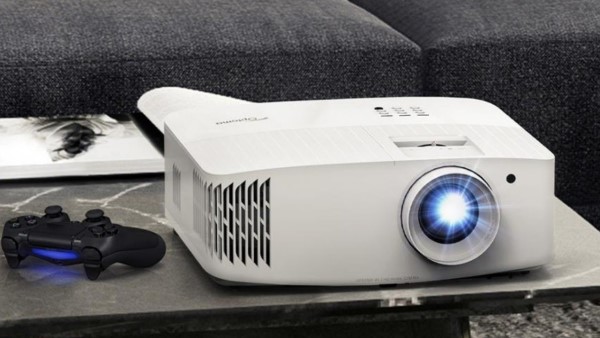
|
Specifications |
|
| Display Type | DLP |
| Maximum Screen Size | 300 inches |
| Brightness | 3,600 ANSI Lumens |
| Dynamic Contrast Ratio | 1,000,000:1 |
| Throw Ratio Range | 1.50:1 – 1.66:1 |
| Lamp Life | 15,000 hours |
| Noise Level | 28 dB |
| Input Lag | 16 ms |
| Warranty | 1 Year |
|
Ratings |
|
| Performance | 9 |
| Design | 8 |
| Ease of Use | 9 |
| Value | 9 |
The Optoma UHD35 is a gaming projector that features core components designed to cater to this specific use case. It has a high refresh rate, low input lag, and a superior dynamic contrast ratio to give gamers the ability to spot enemies or objects in extremely dark or bright gameplay situations.
The UHD35 is optimized for gaming consoles like the PlayStation 5 and Xbox Series X. It produces a dynamic range of colors in high resolution and refresh rates to keep up with fast-paced games.
The UHD35 offers more than just a large high-resolution screen for your favorite games. It delivers gaming performance that was previously only available to premium televisions and monitors. Most notably, it has a meager input lag rating, so you experience a minimal delay when you press a button on your controller.
In gaming mode, the UHD35 can reduce input lag to as low as four milliseconds. Generally, the acceptable input delay for gaming ranges from 16 milliseconds to 30 milliseconds. It also has a 240 Hz refresh rate to eliminate motion blur. You are unlikely to take advantage of the high refresh rate since current-generation consoles can barely realize 4K 120 Hz gameplay. Moreover, the UHD35 is limited to HDMI 2.0 and HDMI 1.4 inputs, so high-refresh-rate and high-resolution gaming is an unrealistic expectation with this projector.
The UHD35 projector uses a 4K DLP chipset and a digital micromirror device from Texas Instruments to achieve this level of performance. It has a high lumen rating and decent color accuracy to make it suitable for movies as well. It even supports HDR10 and HLG to deliver a cinematic experience at home. It also utilizes the manufacturer’s proprietary color wheel to produce some of the most realistic and accurate colors at this price point.
In terms of image quality, the UHD35 has balanced and accurate calibration right out of the box. The colors are not oversaturated, and the projected image is vivid. This projector also gives you the option to tweak the color settings to your preference.
Overall, the UHD35 is an excellent projector for home theaters or bedrooms. It also has a high lumen rating that makes it suitable for rooms with moderate ambient light. This projector offers a fantastic cinema and gaming performance at a very appealing price point. The only drawback of this device is the loud audible fan noise that can get annoying if you sit close to the projector.
Best 4K Projectors Under $1,000
BenQ TK800M
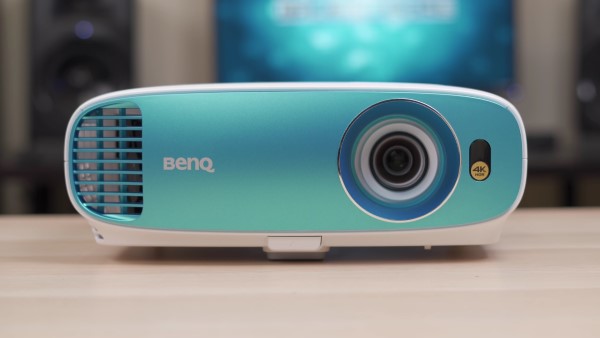
|
Specifications |
|
| Display Type | DLP |
| Maximum Screen Size | 300 inches |
| Brightness | 3,000 ANSI Lumens |
| Contrast Ratio | 10,000:1 |
| Throw Ratio Range | 1.50:1 – 1.65:1 |
| Lamp Life | 15,000 hours |
| Noise Level | 33 dB |
| Input Lag | 49 ms |
| Warranty | 3 Years |
|
Ratings |
|
| Performance | 8 |
| Design | 9 |
| Ease of Use | 9 |
| Value | 10 |
The BenQ TK800M is a dedicated home entertainment projector. It has a 4K DLP chipset and uses a digital micromirror device imaging chip from Texas Instruments for excellent pixel-shifting technology implementation. It utilizes the same chipset design as the HT3350, which performs spectacularly for dark-room viewing.
The TK800M is a lightweight and portable projector that you can take for presentations in business meetings and conferences. You can also take it outdoors for sports viewing parties with friends or backyard movie nights with your family. This projector even supports HDR10 and HLG, making it suitable for watching movies or streaming content with that format.
The TK800M features a proprietary color rendition technology that tames oversaturated reds and greens for HDR10. This technology also helps bring out details in overly dark or bright images.
The TK800M is marketed as a sports projector that features dedicated picture modes for sports. It has a high peak brightness output and uses a new RGBW color wheel that increases the color gamut from 92% to 96% to produce more vivid colors than its predecessor. However, the white segment in the color wheel tends to punch up the brightness at the expense of black levels. Nevertheless, the high lumen rating allows this projector to perform well even in environments with abundant ambient light.
The TK800M has an excellent 4K DLP chipset design that prevents any alignment issues. It also utilizes an optical system with a seven-element, four-group, all-glass lens that effectively minimizes chromatic aberration and maintains sharp image quality.
While most onboard speakers on projectors are underwhelming, the TK800M has a good built-in audio system. The speaker uses an aluminum diaphragm and a neodymium magnet in a resonant chamber to produce decent sound quality. It houses a 5 W amplifier that drives the speaker and even features sound modes and equalizer algorithms that take the audio quality to the next level. However, it should be noted that the onboard speaker can only produce mono sound, and it is nowhere as good as a dedicated external sound system.
The TK800M offers automatic vertical keystone correction to prevent the projected image from being distorted. Generally, you should avoid making keystone corrections because it can reduce the overall sharpness of an image. Still, it is a nice feature to have just if you can’t position the projector properly.
Overall, the TK800M is an excellent budget home entertainment projector. It performs well in ambient light, but it isn’t as good as some of our other picks when it comes to dark-room viewing.
Optoma UHD30
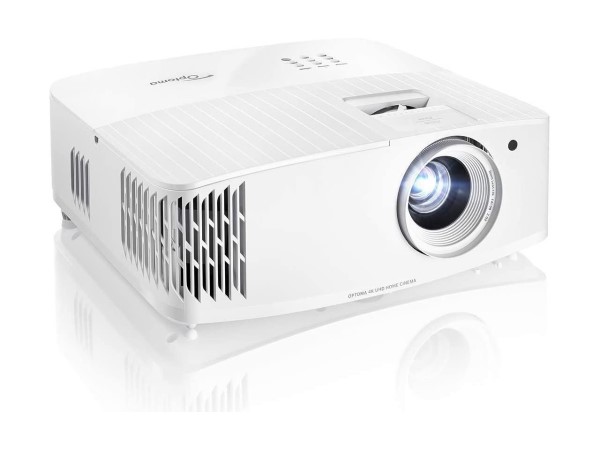
|
Specifications |
|
| Display Type | DLP |
| Maximum Screen Size | 302 inches |
| Brightness | 3,400 ANSI Lumens |
| Dynamic Contrast Ratio | 500,000:1 |
| Throw Ratio Range | 1.50:1 – 1.66:1 |
| Lamp Life | 15,000 hours |
| Noise Level | 26 dB |
| Input Lag | 25 ms |
| Warranty | 1 Year |
|
Ratings |
|
| Performance | 8 |
| Design | 8 |
| Ease of Use | 9 |
| Value | 9 |
The Optoma UHD30 takes its high resolution to another level by integrating proprietary technology that enhances the most minute of details in the projected image. This projector uses an eight-segment color wheel that supports HDR10 and HGL color sets. So whether you’re watching movies or playing video games, it produces rich colors to enhance your viewing experience.
The UHD30 also uses a proprietary technology that enhances the image’s depth and contrasts to make blacks darker and whites brighter without compromising detail and sharpness. While it doesn’t have as low an input lag rating as the UHD35, it is still low enough for casual gaming. In gaming mode, the standard 25-millisecond input lag drops to as low as 16 milliseconds at the expense of image quality. If you don’t want to compromise on the visuals, you can use the other picture modes and still get a decent input lag rating of around 30 milliseconds. This projector also has an incredible 240 Hz refresh rate to eliminate motion blur in games and movies.
One of the most significant downsides of the UHD30 is its long throw distance. If you don’t have much space in your home theater or bedroom, this projector can be a bit of a hassle to install. Nevertheless, it offers more than enough features to make up for its drawbacks, making it a worthwhile addition to your home entertainment system.
Vivitek HK2288
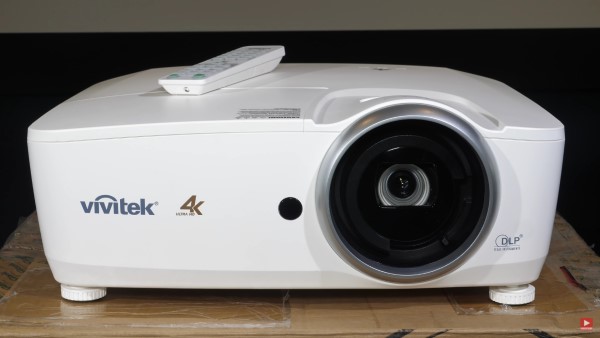
|
Specifications |
|
| Display Type | DLP |
| Maximum Screen Size | 325 inches |
| Brightness | 2,000 ANSI Lumens |
| Contrast Ratio | 100,000:1 |
| Throw Ratio Range | 1.39:1 – 2.09:1 |
| Lamp Life | 5,000 hours |
| Noise Level | 35 dB |
| Input Lag | 62 ms |
| Warranty | 3 Years |
|
Ratings |
|
| Performance | 9 |
| Design | 7 |
| Ease of Use | 7 |
| Value | 10 |
The Vivitek HK2288 stands out among budget high-resolution projectors in terms of build quality. It weighs substantially more than its competitors at the same price range, making it unsuitable for users who want a portable display device for business meetings and conferences. However, it does house some powerful hardware that explains its massive chassis.
The HK2288 features three HDCP 2.2 HDMI ports, allowing you to connect multiple sources to the projector. Most of the competing projectors at the same price point have two HDMI ports with only one port with HDCP 2.2 enabled. Another feature that makes this projector very appealing is the vertical lens shift that significantly simplifies installation.
The HK2288 is currently the cheapest 4K projector on the market. It uses the same 4K DLP chipset as the Optoma UHD60, but the ViewSonic PX727-4K, the Optoma UHD51A, and the BenQ HT2550 all use a newer chipset. There is no significant difference in image quality and resolution between the two chipsets, but the newer chip allows for higher light output and additional flexibility to achieve higher contrast.
The HK2288 has a very robust chassis to match its size. It is made of high-quality material to protect the lens and all the other internal components.
In terms of image quality, the HK2288 has excellent picture reproduction right out of the box. The image is sharp, and the combination of contrast and saturation is visually satisfying. However, the color balance in the preset picture modes can be inaccurate as it tends to push slightly towards cool blue. However, you can easily address this issue by manually recalibrating the color settings.
Overall, the HK2288 offers outstanding value for your money despite the color idiosyncrasies. Once you have it calibrated to your preference, you will end up with a stunning image that significantly enhances your projection experience.
Buyer’s Guide
In this section, we will go on an in-depth discussion of the common features between our product selections. We will also go over which projectors excel in specific aspects to give you an idea of which option is best for your use case. From the technology integrated by the manufacturers to the ease of use, you must consider every facet of a projector before making a purchase. Towards the end, we will answer some of the most frequently asked questions about budget projectors to help you better understand these devices to ensure you make a smart investment.
The first thing you should know about most budget 4K projectors is that they don’t actually have a resolution of 3830 × 2160. Instead, these models are integrated with lower-resolution imaging chips and use innovative methods to produce 4K images.
According to consumer association standards, any projector that can project 8.3 million pixels on the screen can be 4K certified. Manufacturers have developed methods to meet the demanded amount of pixels without using a 4K chip, making the 4K experience cost significantly less than ever before.
The most common of these methods is often referred to as pixel shifting. It involves using multiple lower-resolution chips and shifting each pixel diagonally to double the resolution. The result is individual pixels that make a more precise and more vibrant image. However, this technique strains the projector lamp, significantly affecting its service life. That means you will have to replace the lamp much earlier than you would if you bought a lower-resolution projector.
Display Type
The display type determines the kind and number of chips used to refract, reflect, and project light and produce the necessary amount of pixels for 4K. There are two display types manufacturers integrate into their projectors:
Digital Light Processing (DLP)
The most popular projection technology among budget 4K projectors is DLP. This display type uses three single-chip digital micromirror devices to create two pixels at the same time per frame. The resulting image is vivid and perfectly suitable for home theaters.
While there are several 4K DLP projectors on this list, the ViewSonic PX727-4K and the Optoma UHD51A stand out since they use the latest and fastest chips for quicker frame changes. 4K DLP projectors are also ideal for gaming when paired with low input lag.
Liquid Crystal Display (LCD)
The other display type used in budget 4K projectors is LCD. This technology involves light passing through two or three LCD chips to create two pixels simultaneously and produce stunning, high-resolution images.
One significant downside of LCD technology is the rainbow effect that can be detrimental to your viewing experience. Fortunately, the only 4K 3LCD projector on this list, the Epson Home Cinema 4010, effectively eliminates rainbow artifacts through high-quality components and innovative internal design.
Screen Size
Screen size should be one of the first considerations when choosing a projector. To pick the appropriate screen size, you should check how much space your designated wall for the projector screen can accommodate. The average screen size of modern projectors ranges between 50 to 300 inches.
Out of all the projectors on this list, the Vivitek HK2288 has the largest maximum screen size at 325 inches. It is an excellent product that is suitable for different occasions. However, you should take these numbers with a grain of salt as overextending your screen often results in distorted image quality. It is ideal to keep your screen size around 120 to 150 inches since it accommodates the perfect ratio of pixels per inch of your screen.
Throw Ratio
The throw ratio is a metric for measuring the throw distance of projectors. Generally, it is calculated as the distance the projector is going to throw divided by the width of the screen.
If you have a small room or a limited placement area, you should carefully consider the throw distance. Some short throw projectors can project from three feet away, while long-throw projectors typically work best from a distance of over ten feet.
Brightness
The general rule for projectors determines that higher brightness levels equate to better image quality. A projector’s brightness helps you identify if it can work well in a well-lit environment or if you need to have a room with minimal ambient lighting. Higher lumen projectors are capable of displaying clear images in ambient light. The other crucial aspects of projectors like contrast ratio and image sharpness have little significance without adequate lumen power.
All of the projectors on this list have more than enough lumen capacity to produce detailed and sharp images. It all boils down to the ambient lighting in the room you plan to install the projector. The Optoma UHD35 has the highest lumen rating out of all the options on this list, making it the most suitable for day use.
Contrast Ratio
The contrast ratio determines the range of brightness between the brightest and darkest shade in an image. A projector with a high contrast ratio can produce highly detailed pictures since it can recreate more shades of a color. A contrast ratio upwards of 10,000:1 is guaranteed to deliver deep blacks and bright whites for realistic imaging.
Ease of Use
Like any other electronic device, a projector should be user-friendly. Some of the most common features that contribute to a projector’s ease of use include multiple remote sensors for complete control and an intuitive software interface. The software should let you make lens adjustments and keystone corrections seamlessly. Some projectors even feature auto adjustments that save you the hassle of having to tweak the image manually.
A projector’s ease of use also applies to the installation process. It should have everything you need to set it up right out of the box, including all the mounting accessories and provisions. More importantly, the ideal projector should give you the option to adjust its picture settings.
Audible Noise
Home theater projectors have cooling fans that help keep temperatures down during operation. This design effectively solves the problem of overheating, but some fans generate audible noise that can be distracting and ruin your viewing experience. The audible noise generated from a projector should be considered, especially if it will be placed close to your seating position.
Lamp Life
The service life of a projector’s light bulb is significant, considering how high resolutions are very taxing to this component. Replacement bulbs are also quite expensive, often costing several hundred dollars.
A projector’s lamp life is hour-rated, reflecting the hours it is expected to last. A lamp life of around 10,000 hours is the standard for budget high-resolution projectors. You should only get a projector with less lamp life if the replacement cost is considerably low.
Most projectors have a dedicated mode that conserves lamp life. You can take advantage of this mode to extend the service life of a lamp while compromising slightly on brightness or picture quality. It should also be noted that 4K LCD projectors have significantly lower lamp lives than 4K DLP alternatives.
Warranty
A projector’s warranty reflects how much the manufacturers believe in the longevity of the device. The ideal projector should have at least a one-year warranty to give you peace of mind if you get a unit with damaged components. Projectors have parts prone to mechanical failure, so it’s best to buy one that protects your investment. Some brands like ViewSonic, BenQ, and Vivitek even offer three-year warranties to gain your trust.
Frequently Asked Questions
What is the cheapest 4K projector?
The Vivitek HK2288 is the cheapest 4K projector we could find. While Vivitek is a relatively unknown brand, the products they have on the market are exceptional performers, including the HK2288. The company even offers a three-year warranty on this projector to protect your money.
Is pixel-shifting technology close to full 4K?
Pixel shifting technology is the closest thing a projector can use to achieve 4K resolution without actually using a 4K chip. While the clarity and sharpness aren’t quite on par with the real deal, pixel-shifting costs so much less to use than a 4K chip for an insignificant difference in image quality.
Are budget 4K projectors worth it?
Cheap 4K projectors introduce you to the future standard of media viewing at a relatively affordable cost. You can consider them as future-proof investments that significantly enhance your home theater experience.
What are the benefits of 4K projectors?
Budget 4K projectors essentially let you recreate a cinema experience at the comforts of your home. You can also use them to display your entire music library or play video games on a large screen without compromising image quality.
- Sharp and Detailed Pictures
The most significant benefits 4K projectors offer are the unparalleled image quality you just won’t get with lower-resolution alternatives. The sheer amount of pixels they produce allow them to deliver mesmerizing images. They let you see the tiny details in movies and games to create outstanding visuals.
- Versatility
Most contents from streaming services and video-sharing websites come with 4K resolution. Having a 4K projector will allow you to view content from platforms like Netflix and YouTube at the highest resolution. Moreover, some 4K projectors are explicitly designed for gaming, featuring low input lag and high refresh rates. If you have gaming consoles capable of 4K gameplay, you can take advantage of a 4K projector to play on a large screen with stunning graphics.
- Eye Comfort
One of the most underappreciated benefits of 4K projectors is how easy they are on the eyes. Most of these devices feature minimal screen flickering, and since you are viewing reflected light, they let you view media without fatiguing your eyes.
- Future-Proof
4K is bound to replace the current display resolution standard any time soon. It is gradually becoming mainstream, so investing in a 4K projector now is a sure-fire way to future-proof your home entertainment system.
Quick Recap: Top 10 Cheapest 4K Projectors on the Market
Best 4K Projectors Under $2,000
Best 4K Projectors Under $1,500
Best 4K Projectors Under $1,000
Conclusion
That wraps up our list of the ten cheapest 4K projectors you can get today. We hope our product suggestions and comprehensive buyer’s guide have helped you shape a smart purchasing decision.
This article was carefully curated to cater to the most specific user requirements, so there should be a projector on this list that meets your demands. So whether you’re putting together a home theater or a gaming nook, this list has a projector for you.






